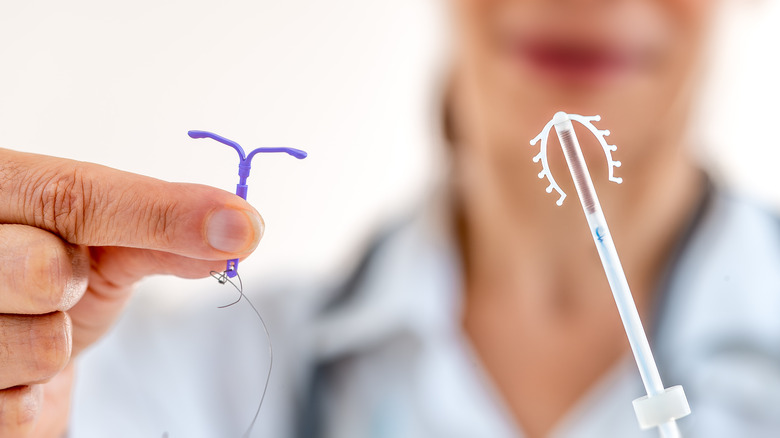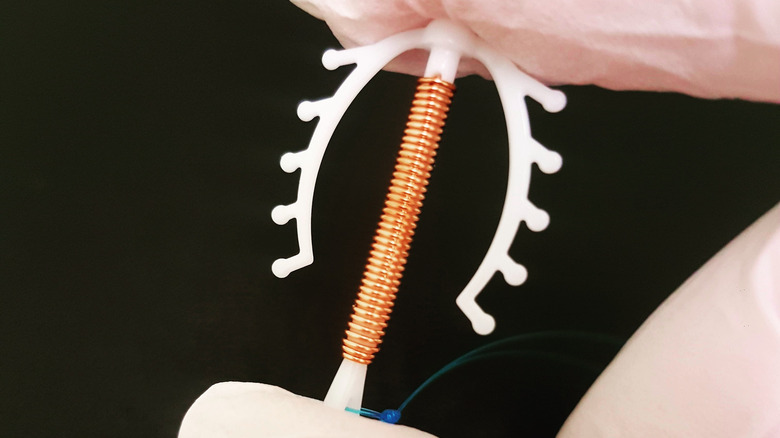Copper Versus Hormonal IUDs: Which Is Right For You?
When it comes to choosing a birth control method, it might feel like you're stuck in a pile of options and information that may feel overwhelming to sort through. From implants to removable uterine rings to the variety of birth control pills on the market, finding the right choice for your body can be confusing, to say the least. The experts at Mayo Clinic recommend first deciding what your needs are since birth control methods aren't just used to prevent conception during sexual intercourse, but many types of birth control can also help with menstrual cycles, regulate hormonal imbalances, and do other things for your body related to your reproductive system and overall health. Some birth control methods may not work for you, whether from side effects or personal choice. Knowing your options is step one.
Intrauterine devices, or IUDs for short, are one type of birth control method that doesn't require daily maintenance, so if you don't like the hassle of taking a daily pill, then an IUD might be a good choice (via WebMD). It is inserted by a doctor into your uterus and can stay in place while remaining effective for up to a decade. However, it can also be removed by your doctor at any time should you decide you no longer want it or would like to try to get pregnant. There are different IUD types to choose from, so here's what you should know about your options.
Copper IUDs last up to a decade
The copper intrauterine device (IUD) is a good choice if you are looking for a birth control method that can be left in for up to 10 years, per Medical News Today. The T-shaped IUD device measures under two inches long, including the two strings that hang from the IUD device itself after the device has been placed inside your cervix. The purpose of the strings is to make the ease of removing the device smoother for your doctor and to allow you to check that your IUD is still in its correct place, which you should do on a regular basis with any type of IUD. The copper portion of this form of IUD serves as a spermicide to prevent sperm from entering the female reproductive system, though it's important to note that the copper IUD is solely a contraceptive device and cannot effectively prevent the transmission of sexually transmitted diseases (STDs) or bacterial infections.
According to a 2016 study published in the Open Access Journal of Contraception, the copper IUD has been approved for use since 1988, with the popularity of IUDs rising significantly between 2009 and 2012. The brand name for the sole copper IUD approved for use in the United States is the ParaGard Copper T, though it's colloquially referred to simply as ParaGard. Approximately 12 years after the Paragard IUD became available in the United States, the use of hormonal IUD options was approved in the year 2000.
Hormonal IUDs can help with period symptoms
Intrauterine devices (IUDs) that are classified as hormonal involve the use of T-shaped devices similar to the copper IUD, but instead of copper strings to act as a spermicide, hormonal IUDs release hormones similar to those available through the birth control pill (via Mayo Clinic). For instance, the Mirena IUD option releases the hormone progestin, which prevents conception by creating thick cervical mucus, which serves as a barrier to block sperm from completing the process of fertilization.
This type of IUD can also subdue ovulation within the female reproductive system, thus relieving painful menstrual cramps and intrusive symptoms of endometriosis. Therefore, if you have painful periods, then a hormonal IUD may be the best choice for you. Other added benefits of hormonal IUDs include reducing the risk of endometrial cancer and decreasing possible infections of the pelvis. While the copper IUD can remain in the body for up to 10 years, hormonal IUDs should be removed within seven years after initial insertion.



